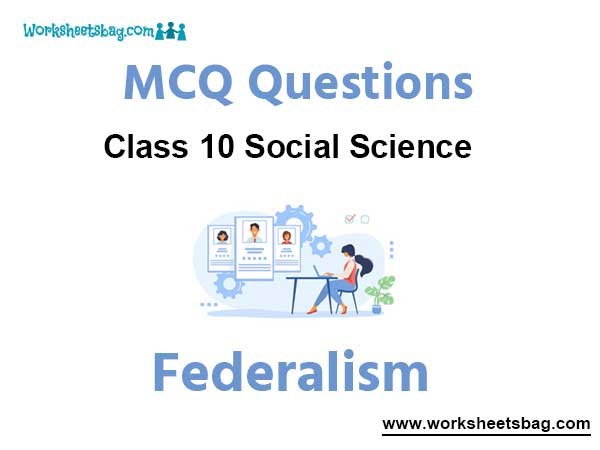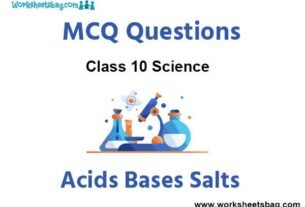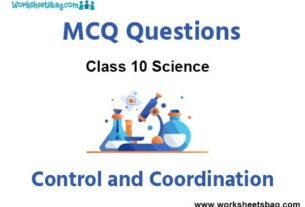Please refer to Federalism MCQ Questions Class 10 Social Science below. These MCQ questions for Class 10 Social Science with answers have been designed as per the latest NCERT, CBSE books, and syllabus issued for the current academic year. These objective questions for Federalism will help you to prepare for the exams and get more marks.
Federalism MCQ Questions Class 10 Social Science
Please see solved MCQ Questions for Federalism in Class 10 Social Science. All questions and answers have been prepared by expert faculty of standard 10 based on the latest examination guidelines.
MCQ Questions Class 10 Social Science Federalism
Question. A few gram panchayats are grouped together to form, what is usually called a
(a) Panchayat Samiti.
(b) Gram Panchayat.
(c) Naya Panchayat.
(d) Zilla Parishad.
Answer
A
Question. The number of subjects listed in the Union list of Indian Constitution is
(a) 90.
(b) 93.
(c) 95.
(d) 99.
Answer
D
Question. The authority that has the power to run the administration of the Union Territories is
(a) Election Commissioner.
(b) Governor.
(c) Central Government.
(d) Chief Minister.
Answer
C
Question. The term ‘jurisdiction’ in a federation means
(a) area of influence.
(b) law.
(c) sovereignty.
(d) autonomy.
Answer
A
Question. The non-scheduled language is
(a) Khasi.
(b) Konkani.
(c) Santhali.
(d) Bodo.
Answer
A
Question. The year in which use of English for official purpose was to end in India was
(a) 1950.
(b) 1956.
(c) 1965.
(d) 1980.
Answer
C
Question. The smallest union territory of India is
(a) Puducherry.
(b) Lakshadweep.
(c) Daman and Diu.
(d) Delhi.
Answer
B
Question. The government organ that resolves the disputes between the Center and the State government is
(a) Parliament.
(b) Armed Forces.
(c) Supreme Court.
(d) President.
Answer
C
Question. Identify the nation that provides special power to its constituents
(a) U.S.A.
(b) Australia.
(c) Spain.
(d) India.
Answer
D
Question. In India , special status is being given to the
(a) Assam.
(b) Bihar.
(c) Jammu and Kashmir.
(d) Mumbai.
Answer
C
Question. Match List-I with List-II and select the correct answer using the codes given below it.
| List-I | List-II |
| A. Union of India | (i) the Prime minister |
| B. State | (ii) Sarpanch |
| C. Municipal corporation | (iii) the Governor |
| D. Gram Panchayat | (iv) Mayor |
(a) A-i, B-iii, C-iv, D-ii
(b) A-i, B-iii, C-ii, D-iv
(c) A-ii, B-iv, C-iii, D-i
(d) A-i, B-iv, C-iii, D-ii
Answer
A
Question. Panchayati Raj System is based on.
(a) Centralisation of power
(b) Decentralisation of power
(c) Co-operation with people and administrator
(d) All of the above
Answer
B
Question. This subject is not in the State list.
(a) Police
(b) Irrigation
(c) Forest
(d) Agriculture
Answer
C
Question. Mark the correct example of the ‘coming together federations’.
(a) Belgium
(b) India
(c) USA
(d) Spain
Answer
C
Question. Which consititutional Amendments implement Rural and Urban democracy in India.
Tick the correct order ?
(a) 52nd and 46th Amendment
(b) 73rd and 74th Amendment
(c) 42nd and 64th Amendment
(d) 74 and 73rd Amendment
Answer
B
Question. Which Article of the Constitution of India gives special status to Jammu and Kashmir ?
(a) Article 365
(b) Article 370
(c) Article 375
(d) Article 380
Answer
B
Question. Mark any one feature of the unitary form of government.
(a) In a unitary government the powers are divided between the centre and the state government.
(b) All the power is with the people.
(c) Power is concentrated with the central government.
(d) State government has all the powers.
Answer
C
Question. Define federalism:
(a) A system of government in which the power is divided between a central authority and constituent political units.
(b) A system of government in which the central government has all the powers.
(c) A system of government in which all the citizens has the power.
(d) A system of government which the minister’s exercise more powers.
Answer
A
Question. The State Reorganization Commission was appointed by
(a) Mahtma Gandhi.
(b) Sardar Patel.
(c) Indira Gandhi.
(d) Pt. Jawahar Lal Nehru.
Answer
D
Question. Identify the type of government for which Tamilians are fighting in Sri Lanka
(a) unitary.
(b) federal.
(c) community.
(d) tyrant.
Answer
B
Question. The Centre and the State governments raise the resources to meet the requirements of administration by
(a) pursuing business activities.
(b) forming cooperatives.
(c) levying taxes.
(d) setting up Public Sector Undertaking (PSU).
Answer
C
Question. Education is a part of which category?
(a) State List
(b) Union List
(c) Concurrent List
(d) Residuary Powers
Answer
C
Question. Mark the correct sentence.
(a) Britain is a federal state.
(b) U.S.A is a unitary state.
(c) States are more powerful in India.
(d) India is a quasi- federal state.
Answer
D
Question. The experiment of combining the decentralization with participative democracy was carried out in
(a) Tamil Nadu
(b) Kerala
(c) Andhra Pradesh
(d) Karnataka
Answer
B
Question. The municipalities are set up in
(a) big cities.
(b) towns.
(c) villages.
(d) districts.
Answer
B
Question. The federal form of government was first established in the
(a) United States of America.
(b) India.
(c) Belgium.
(d) Sri Lanka.
Answer
A
Question. Which State became 22nd State of India on 26th April, 1975 ?
(a) Nagaland
(b) Tripura
(c) Himachal Pradesh
(d) Sikkim
Answer
D
Question. Which among the following is the biggest and strongest obstac le in the way of National Integration of india.
(a) Linguistic policy declared by the government
(b) Financial crisis faced by the National Integration council
(c) Formation of states on the basis of Language
(d) Lack of strong and sound National Conciousness
Answer
D
FILL IN THE BLANKS
Question. Indian constitution provides _________ tiers of government.
Answer
three
Question. The area over which someone has legal authority is known as _________ .
Answer
Juridiction
Question. _________ is the political head of Municipal corporation.
Answer
Mayor
Question. The constitution declared India as a ‘Union of States’ which is based on the principle of _________.
Answer
Federalism
Question. In India at least one third of all positions are reserved for women in _________ .
Answer
Panchayti Raj System
TRUE / FALSE
Question. Around 41%, Indian use hindi as their mother tongue.
Answer
True
Question. Legislative has the right to solve controvercy regarding the division of power in India.
Answer
False
Question. Belgium adopted federal type of government instead of unitary government.
Answer
True
Question. Only centre has jurisdiction over residuarly subjects.
Answer
True
Question. Match the following :
| Column A | Column B |
| 1. Union of India | (A) Mayor |
| 2. Central and State governments | (B) Concurrent List |
| 3. Municipal Corporation | (C) Prime Minister |
| 4. State | (D) Sarpanch |
| 5. Gram Panchayat | (E) Governor |
Answers :
1. (C), 2. (B), 3. (A), 4. (E), 5. (D)



